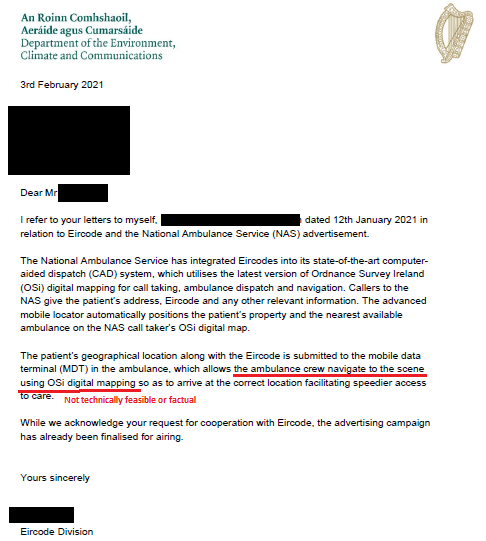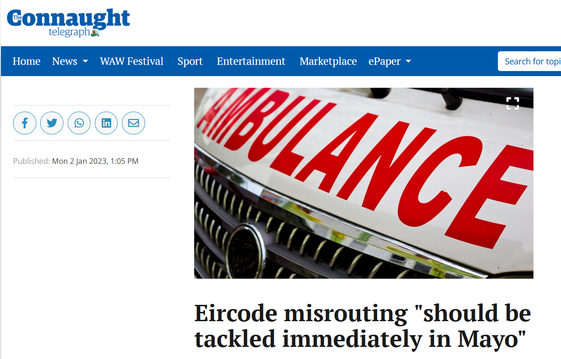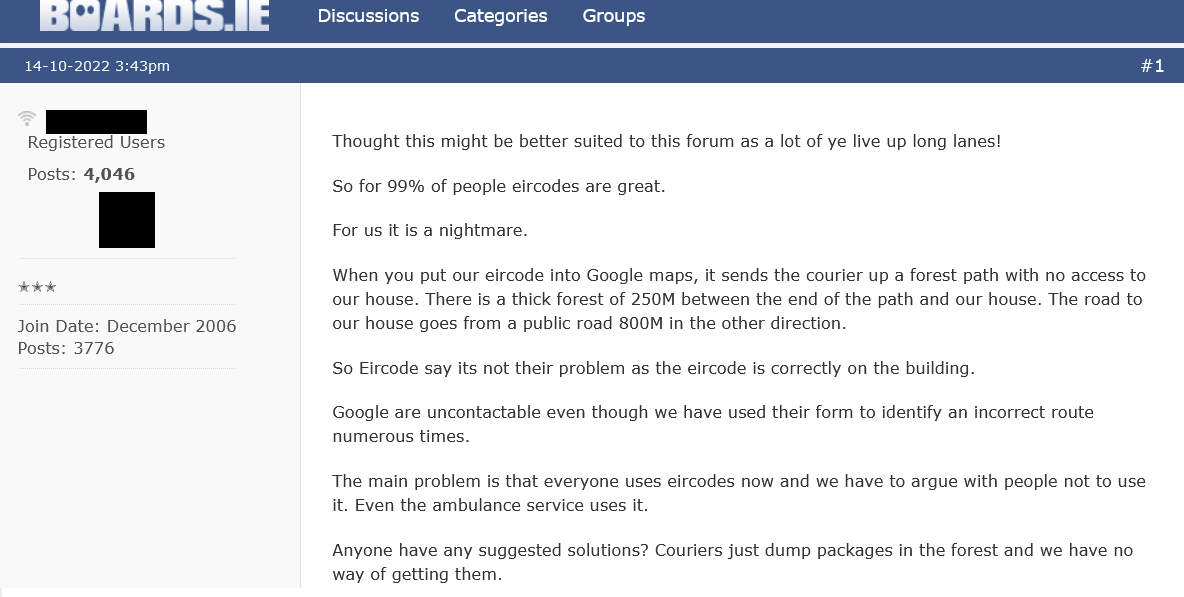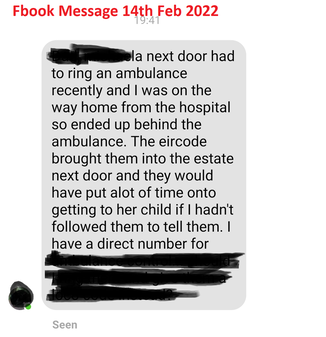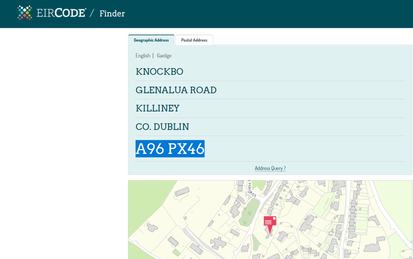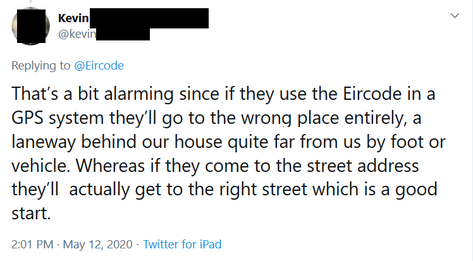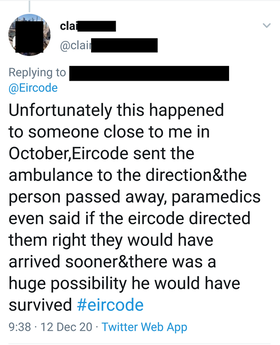In answers to two Parliamentary Questions (PQ's) from Brendan Griffin TD on 11th July 2023, the Minister for Communications identifies An Post as the organisation to contact if there is a location or address issue with Eircode and states that Satnav systems can misroute even if the Eircode location from An Post is correct. Effectively, even though the Department of Communications and Capita have been promoting Eircode for use when calling an ambulance since 2015, this is the first time that the potential for misrouting if an Eircode is used is publicly admitted. This is a Public Safety Issue. Neither Capita, who produced the Eircode ambulance advert, nor the Department, which approved that it could be broadcast by RTE as a Public Service Announcement (PSA) and paid for by TV license payers, have never previously publicly admitted that misrouting could occur if an Eircode is used. This blog has previously explained how misrouting occurs in SatNav systems and we have provided multiple examples of how it has delayed ambulances getting to patients on numerous verifiable occasions. (as well as causing confusion and delays for deliveries of goods and services) We have also shown that this is an issue that was well known to navigation industry experts before Eircode was ever conceived and that the designers of Eircode could and should have taken it into account. Furthermore, we have also shown in our blog posts that in the vast majority of cases simply moving the location of an Eircode by a small amount can solve the problem. However, this is not acknowledged in the answer to the PQ's referenced above and when one of the PQ's identifies An Post as responsible for Eircode location issues, it also directs the blame to An Post as An Post's design rules for Eircode do not permit movement of the related location away (even by a small distance) from that which is recorded in An Post's Geodirectory. By simply removing this rule, many of the misrouting issues identified to date could be immediately resolved. It is because Loc8 Code allows flexibility as to where the destination location is marked, it can resolve Eircode misrouting issues instantly and that is why we recommend it as a solution in our Guide to checking and resolving Eircode misrouting here It is notable that in his response to the PQ's that the Minister does not highlight that the Eircode Satnav routing issues which he refers to, could also misroute an ambulance and, as a result, there is a need for people to check their codes before relying on them in emergencies. This is in spite of the fact that his Department and Capita, under contract to the Department, with the support of An Post, promotes Eircode for emergency Navigation by the ambulance service through PSA's which have been repeated every year since 2015. Equally the Minister does not mention that even though both Capita and his Department have previously recommended that members of the Public contact Google Maps to ask them to solve the issue, there is never any mention that since the Ambulance Service does not use Google Maps (same for many others), resolving the issue with Google Maps may still leave the same misrouting issue for ambulances. We have also highlighted this in our related blog posts here Misrouting relating to Eircode use on Satnavs has been known about by those involved with Eircode since at least 2016. (Autoaddress was a subcontractor to Capita for the roll-out of Eircode) However, those directly responsible, especially Officials in the Department of Communications, have denied misrouting even when raised with them officially. Their denials have been accompanied by misinformation such as the idea that ambulances use Ordnance Survey of Ireland (OSI - now Tailte Éireann) mapping for Navigation (they use Trimble Maps in the Co-Pilot Navigation system) It is good, therefore, to finally have the Minister representing the Department of Communications officially admitting that that Eircode related misrouting does actually occur when his Officials & Contractors have previously failed to do that. He should now, therefore, commence a National and highly visible campaign to warn the Public that this may happen when an Eircode is used in calls to the ambulance service and, if the Eircode ambulance advert is to be broadcast as a PSA again, then it should also include that warning. This is a Public Safety Issue so all such warnings should advise the Public to check their codes and we at checkyourcode.ie are more than willing to work with the Department, Capita and An Post to facilitate that checking and help with the quick solutions if an Eircode does suffer from misrouting. Finally, when the Minister stated in his answer to the PQ that he has "no direct function" relating to the "accuracy of these directions" , this is NOT TRUE :-
The Minister's own Duty of Care to the Public he serves should dictate appropriate action once he has become aware of the related issues. The answer to this PQ confirms that he is now aware of Eircode related misrouting. You would imagine also that RTE and its new DG, Kevin Bakhurst, would no longer allow a Public Service Announcement be broadcast on its platforms without inherent warnings to the Public, since it is now officially acknowledged that the Minister is aware of related issues? Following on from our blog post 3 days ago - The Connaught Telegraph has published this article - Eircode misrouting should be tackled immediately in Mayo 30/12/2022 Eircode Misrouting Identified by Councillors in Castlebar But Dangers For Residents Not RecognisedHere we are at the end of 2022, almost 9 years since Eircode was launched, and another case of Eircode misrouting is identified. This time it is being identified by Councillor Ger Deere and Iarla Moran, Head of the Municipal District, in Castlebar, Co Mayo, without understanding the potential dangers of this if a resident of the named street has to call for an ambulance. Instead of an Eircode which "directs" to the wrong street being a "not serious" "inconvenience" as suggested by the Connaught Telegraph Article, it could actually result in an ambulance being delayed getting to a patient in a case where minutes or maybe just seconds are critical. This is a particularly worrying possibility in a scenario where total reliance on Eircode and belief in its infallibility may have been created. It is just about 6 months since a similar article appeared in the Irish Examiner reporting confusion with street & estate names. In that article on the 24th of June last problems caused for Gardai were acknowledged. What these articles are telling us is that Eircode has not fixed well known problems with property addressing in Ireland and , in fact, it seems to be associated with making matters worse as suggested in this article from 2017. It also tells us those who run our cities, municipalities and rural areas have been convinced by Public Service Announcements, marketing and political statements that Eircode is flawlessly precise and a perfect destination identifier for Navigation, when this Newsblog makes it abundantly clear that it is not. Furthermore, we can also see that there is confusion as to who is responsible. Because it was recognised before Eircode that we had significant issues with our property addressing system and because this appears to have deteriorated further in recent years, an over reliance on Eircode is being caused. Amongst the public in general and those who respond to emergencies, there is a bias that addresses cannot be relied upon at all so, they should be ignored in favour of total reliance on Eircode. In the professional discipline of Navigation, this is a recipe for disaster. Since it is well proven on this Newsblog that Eircode can & has misrouted, that disaster may well be related to the loss of life. I regret to say that, in the not too distant future, this subject may end up for consideration in a Coroner's Court where over reliance on Eircode, a failure to understand its limitations, the undermining of property addressing and all the people and factors that contributed to these, will be exposed in detail. Just like air or marine accident investigations, it will be found that contributing factors were obvious to those responsible for related oversight for some time but were consistently set-aside and/or ignored. Iarla Moran suggests in the Connaught Telegraph article that Eircode and street addressing have nothing to do with the Council. When it comes to property addressing, that is not entirely true but this article makes it clear that property addressing is nothing to do with Eircode. Nor is it anything to do with Google Maps. In fact, it is useful to know that the Postal Addressing associated with Eircode is not actually passed to Google Maps when Eircodes are passed on. However, as has been discussed in this Newsblog many times, it may be possible to resolve misrouting on Google Maps by making contact with Google BUT this does not assure that the same problem is resolved on other mapping and navigation systems used by emergency services or logistics companies. As we have highlighted before, the National Ambulance Service does not navigate to an Eircode location using Google Maps. We have to be very clear here, whilst property addressing is mainly an issue for An Post (with input from Local Authorities), Eircode misrouting is the sole responsibility of Capita which manages Eircode for the State. The misrouting wrongly identified as an "inconvenience" in the article should be brought to the attention of Eircode immediately and they must ensure that whatever steps are necessary to resolve the issue in ALL mapping and navigation systems, especially those used by emergency responders, are undertaken as a matter of urgency;- with unambiguous confirmations when achieved. As we reach the end of another year where evidence of the misrouting of ambulances has been prominent and the absence of warnings from those responsible has been conspicuous, we can only hope that 2023 will be better in the best interests of Public Safety for all residents in Ireland! We have been made aware of yet another case of Eircode misrouting where an ambulance was delayed as a result. For this reason, we have added a new "Point 5" to our list for checking an Eircode here -/>  On the afternoon of the 3rd November last, we received a call from a lady who had called an ambulance for her father a few days earlier but the ambulance was delayed as a result of Eircode misrouting. She made contact with us to confirm she could use a Loc8 Code when calling for an ambulance in the future. In this case, Google Maps had been corrected to include a short private driveway;- so if she had done our check and had not read our NewsBlog articles she would have assumed misrouting could not take place. However, there was another road running along a different side of her house from which there was no driveway but it was closer. CoPilot, which the ambulance service uses, did not have the corrected driveway to the house, so the ambulance ended up on the closer road from which there was no access to their patient and no visibility to or from the house. This caused a delay until all realised that there had been a misrouting error. For that reason, our new Point 5. states as follows: "5. If there is a road shown on Google Maps between your road access & your house, this road may not be on other mapping systems such as "CoPilot" which the ambulance service uses. If there is another road on the maps closer to your house than your own road access then, misrouting could occur and, therefore, you should also create & use a Loc8 Code to be safe. As different emergency responders and other service providers use different Navigation systems with different map suppliers, it is not possible to check them all. For that reason, best to be safe & use a Loc8 Code." In addition, because the actual access to this property from the road is very narrow and bordered on 2 sides by other houses, even with a Loc8 Code generated just inside the access point, there could still be doubt. For that reason we would recommend Confirmation Signage at the gate which would say "Access to Eircode &/or Loc8 Code xxxxxxxxx" This would remove any possibility of doubt amongst the paramedics navigating the ambulance. Confirmatory signage like this is very useful in navigation and is highly recommended where there might be any doubt. The responsibility for this kind of confirmation is on the property owner;- not the paramedics or other service providers trying to find them. It is extremely regrettable that those behind Eircode are not even warning the public about the possibility of errors or misrouting;- let alone advising how to check and resolve issues before they happen and cause risk to public safety. If you need any clarifications on any of this, please contact us here -/> Misrouting of vehicles, including ambulances and 1st responders, by Eircode has been reported for many years now. New examples keep being reported through social media and that means there are many more that go unreported. The above image is from a post a few days ago in boards.ie and is just one more of many many examples. Those who report Eircode mis-routing in relation to deliveries do not always realise that the very same could happen if an ambulance is trying to find them........ ;- but with potentially life and death related consequences. Even though Eircode & the Department of Communications promote their product through Public Service Announcements (PSA's) on RTE for ambulance emergency response, they continue to fail to take any responsibility when a misrouting report raises the possibility of an ambulance being led astray and delayed. They also have taken no steps to warn the public about this well documented issue. Eircode misrouting is predictable and can be avoided. It is explained in detail in our post here -/> We are aware that in previous cases Capita personnel have advised those reporting the issue to contact Google Maps to get them to help solve the problem (not always possible or timely). Not only have they not admitted that by simply moving the location of the Eircode themselves they could resolve the problem, they also fail to advise those with the problem that even if they get the problem solved in Google Maps, the issue may well remain for ambulances as they use a different mapping system (CoPilot - Trimble Maps). Furthermore, other service providers may be using Garmin/Navigon, TomTom or other navigation/map systems which all would have to be contacted to fully (though possibly temporarily) correct a problem which Eircode created and could solve themselves. Unfortunately, Eircode will not do as required to resolve the matter as the An Post design specifications for Eircode limit what the code can point to. The quickest solution for those experiencing Eircode mis-routing is to generate a Loc8 Code for the access to the desired property using the web-app here -/> Then create a sign with the Loc8 Code on it and place for all to see - guidelines for displaying Eircodes or Loc8 Codes are here -/> It is important to understand that the National Ambulance Service has fully integrated Loc8 Code into their systems side-by-side with Eircode since 2017. If you are reading this post, please #checkyourcode , advise others to do so also and please do it for those who can't. We are very happy to help and you can make contact with us here -/> Regrettably, we are yet again reporting another recent case of an ambulance being delayed as a result of Eircode. We have investigated the cause and have confirmed that this is another case of Eircode misrouting. Firstly, let us assure readers that in spite of the related delay, the woman involved is recovering well thanks to the expert work of National Ambulance Service paramedics when they got to her. We wish her a speedy recovery and congratulate her son for all that he did to ensure his mother got quick medical care. This misrouting issue was caused once again by the fact that Eircode simply identifies a location and does not take into account the route by which that location can be accessed - i.e. it gives no clue as to where the access is and, due to inflexibility of design, cannot be adjusted to do that. In this case, the navigation mapping used by the Ambulance Service calculated a route via the nearest mapped road on its system to the Eircode location. This is how navigation systems normally work. There was no access from this location and, therefore, paramedics then had to go through a process of checking if they have the right code and finding a different way to it;- all using up valuable time. Time, as you know, is absolutely critical when it comes to a stroke patient. Capita PLC, which trades in Ireland under its registered business name of Eircode, has admitted in email exchanges that Eircode has no routing capability and then proceeds to suggest how multiple international mapping & navigation companies can be contacted by the property owner to ask them to resolve the issue. This of course suggests that the problem is with those companies and not Eircode. Let us spell it out again.................................................... those companies DO NOT CLAIM in a Public Service Announcement broadcast, at license payer's expense on RTE networks every year during January to March since 2016 (broadcast just finished for this year), that their product "may help an ambulance find you faster." Those companies acknowledge that their routing solutions can be sometimes less than perfect due to variations and inaccuracies in mapping. However, none of them designed a National Postcode over the period 2005 to 2014, with a current cost to the Irish exchequer of over €50M;- completely ignoring what is navigation industry knowledge and without reference to navigation experts. Furthermore, those companies have not ignored multiple well documented requests that Eircode should warn people of possible errors in their codes with the possibility of misrouting and encourage them to check their code at least once before relying on it in an emergency. Not only has the Department of Communications & Eircode (Capita PLC) ignored requests to include the warning in their adverts, in a response to a letter to them in 2021 on the subject, the Head of the Eircode Division in the Department of Communications, Mr. Ben King, implied that misrouting did not occur because the Ambulance Service uses Ordnance Survey Mapping. There are three aspects to this response & inherent implication as follows:-
There are short, medium and long term solutions to this misrouting issue which can be applied (some here on our site) BUT the very 1st step is for all those behind Eircode to start admitting that there is a problem and to warn the public about it. There is a quick short term solution which is already supported by the Ambulance Service and mentioned on this website. Very simply put, if the Eircode advert broadcast as a Public Service Announcement Free of Charge on RTE over the last 8 weeks had included a simple warning to the Public to check their codes and to use this website to help them do it, then this incident of Eircode misrouting could have been avoided. Likewise, this misrouting incident which also happened this February could also have been avoided. RTE has also been advised of this issue but has chosen not to apply any due diligence to the nature of advertisements broadcast on their networks as Public Service Announcements. It is RTE's assertion that once a Government agency tells them to broadcast something as a Public Service Announcement, they will do it without applying any oversight criteria. It is not good enough that Eircode (Capita PLC) and the Eircode Division in the Department of Communications is not warning people of this problem but it is also not good enough that they are not ensuring new & corrected Eircodes get to Google Maps in a timely manner either. This means that 1st responders do not know that if they are using Google Maps, a new Eircode may not be there at all or, if a correction has been undertaken by Eircode to adjust the location of a code, this also may not have been applied in Google Maps causing them to be guided to the wrong location. In the last week, two newspaper articles have confirmed that An Post's post men and women cannot use Eircode to deliver letters;- something that was established by then Deputy Hildegarde Naughton as Chair of the Oirecahtas Communications Committee in 2017/18. She did nothing and told no one about this at the time. The issue of Eircode misrouting has been raised since 2015 and we continue to hear of new examples where ambulances are delayed and patients put at risk but the same Hildegarde Naughton TD, who is now the Minister with Responsibility for Eircode, is not doing anything about that either. We at checkyourcode.ie have the expertise to help solve these problems and are more than willing to help the National Ambulance Service & Public representatives make it happen. Please let us do this together before someone loses their life as a result.
21/5/2021 More Evidence of Eircode MisroutingMore & more evidence of Eircode causing vehicles to be mis-routed away from the correct address is becoming available;- causing missed or incorrect deliveries, missed broadband or utility connections/repairs and delays for 1st & emergency responders Letters to senior Officials of the Department of Communications in January 2021 raising the issue with them and asking that warnings be applied to Public Service Announcements were not successful. They chose not to tell anyone about the issue which can be easily resolved if people are made aware. As a result, people are still taken by surprise as a result of Eircode mis-routing and are unaware that it can be resolved to everyone's benefit. This article explains the issue and this page explains how to identify and resolve it As mis-routing of ambulances by Eircode can put patients' lives at risk, it is important to understand & warn about it Firstly, to understand this issue, you must understand that electronic navigation systems will route to a point on the suitably mapped road nearest to the location of the chosen destination. This is the case for ALL electronic navigation systems whether using Google Maps, Apple Maps, Here Maps in Garmin devices or any other maps in any other electronic navigation systems. Those who are experienced in Navigation & Satellite Navigation (SatNav) will be familiar with this issue which is well understood for many years. It is not a new phenomenon and it existed well before Eircode was conceived. The example we will take from Eircode Finder is as follows: As many people are familiar with Google Maps, lets look at it there but we are going to use the Loc8 Code point8 app so we can show how Eircode mis-routing can be easily solved using a Loc8 Code. Loc8 Code is fully supported by the National Ambulance Service (NAS) side by side with Eircode. The app also allows you to easily check for mis-routing with your Eircode. To do this yourself go to www.loc8.ie/point8, use the drop down box at the top left to select the Eircode option & then enter Eircode A96 PX46 to see the location on the map as shown below:- From the satellite imagery you will note that the entrance to the property is as marked with the yellow "X" on Glenalua Road;- Glenalua Road being part of the postal address for the property. If your device has identified your own location, then you can now click on the "Route" menu option on the point8 app. You will see a blue line showing the route to the East (Right) of the property. You can zoom out to see more of the proposed route. You are only interested in the last few hundred metres or so. You will note that the proposed route brings you to a different property, with a different Eircode, a different address and with access from a different road. So, in this case, an ambulance (or CFR) would be routed to the wrong property, approximately 600m along the road from the correct address. This would also be the case for anyone else trying to find the property, and it maybe the reason if parcel deliveries are being dropped at the wrong house. Looking at the map from overhead, as we are, it is of course easy to spot the issue and then resolve it. However, put yourself in the position of paramedics in an ambulance trying to get to a patient on a dark Irish winter's night. Their destination has been sent by Control to their Data Terminal (Communications, GPS, Mapping & Navigation). Their focus is on getting to the destination to administer medical assistance and they mostly are not aware of the potential for this mis-routing to happen or what causes it. In daylight, this next image is what they would be looking at as they approach;- a cluster of houses with an instruction from their navigation device that their destination is close ahead or that they have already arrived, but neither is the case. At night time, there would be very little illumination, confusion as there is no one to meet them and a reticence to knock on doors because of the late hour. There is no direct connection between this location & the patient's property. The automatic assumption is that either the Eircode was wrong or there is a map error. What follows next, is a series of calls to ambulance control, calls to the the patient (if conscious or if there is someone with the patient) and, eventually & hopefully, verbal directions to the correct house. The ambulance will have been delayed with associated risk to the patient. This example is in an urban area, but if in a rural area at night the mis-routing & delay could be more significant and a life could be at risk as is suggested in the tweet below (unrelated to our Eircode example) from a member of the public just a few weeks ago. What caused this Eircode mis-routing? As stated earlier, all navigation systems will provide a routing solution to the point on the suitably mapped road nearest to the location of the selected destination point. In the case of Eircode P46 PX46, that point on the nearest suitably mapped road is 38metres away;- thereby causing a routing solution via a different property, a different address and a different road from which there is no access. Whilst, this example is being presented to you using Google Maps, the issue would be same in other electronic map/navigation systems if they have the same mapped road features. Most are very much the same nowadays but with some variations. This is an issue well known to those who are experienced in electronic navigation and it is something that an expert in the field would have ensured was addressed in designing a modern postcode system. As Eircode was designed without the involvement of consultants with navigation expertise and without consideration of navigation design requirements in the design document published in May 2014 by Capita PLC, the design does not take into consideration how this known issue could be resolved. In fact, neither the contract for Eircode nor the design specification mentions either navigation or emergency response (ambulances or other) and, therefore, there was no responsibility on those involved to consider the related requirements. Autoaddress, which was a contractor involved in the delivery of Eircode, has recognised that Eircode mis-routing does occur but wrongly claims that it cannot affect ambulances. They claim that this is because the Ambulance Service uses Ordnance Survey Mapping. This is only partly true. They do indeed use Ordnance Survey Mapping on their computer systems in their National Control Centre where emergency calls are taken and locations are visualised by operators. However, Ordnance Survey (OS) mapping does not have the "attribute" or "meta" data necessary to help generate electronic routing solutions, so when an ambulance generates routes to Eircode destinations, it is not using OS mapping. Therefore, ambulances are indeed vulnerable to mis-routing as demonstrated in this article. We can only deduce that because Autoaddress personnel are not familiar with navigation technology, they have misunderstood the facts in this case. Furthermore, as the applications of navigation or emergency response were not considered in the design specification for the National Postcode, the locations to be used for each Eircode were taken to be those already in use with An Post's GeoDirectory. GeoDirectory was designed for address and property identification and, therefore, uses locations which point to buildings. When it comes to navigation, access points from roads are often of more interest than the actual location of a building itself. Since Eircode is now mostly used for navigation, this can be considered as a design oversight and, because An Post will not allow the locations from GeoDirectory to be altered, this means that moving the locations used for Eircodes cannot be adopted as a solution. For this reason, Eircode will cause and continue to be susceptible to mis-routing. This issue was identified well before Eircode was rolled out in evidence to an Oireachtas Committee in June 2015. (see Page 14, Para 6.h. & other references in the document) It has also been frequently reported on social media. How can this Eircode mis-routing be resolved? When designing a piece of national infrastructure which has to be used with multiple mapping solutions, by many people with different capabilities and for many applications with multiple design requirements, it has to be as flexible as possible to meet all these needs. However, as stated above, Eircode was not designed either for navigation or emergency response. To redress that issue now there are multiple possibilities. Most would take a long time, would not be practical, may not be applied consistently, could not be done by the public themselves and none would be 100% reliable or satisfactory. However, the National Ambulance Service fully integrated Loc8 Code into its control Mapping and ambulance navigation systems during 2017 so that it is supported since then, side-by-side with Eircode. To be clear about his, Loc8 Code is coded by programmers into the applications that controllers use in National Emergency Operations Centre (NEOC). They do not use external applications for Loc8 Code and have access to the Loc8 coding to implement it in any of the systems they use as required. Unlike Eircode, Loc8 Code can be generated by anyone (including ambulance controllers) for any location so it can be used to generate a location which can be used by an ambulance (or CFR) to avoid Eircode mis-routing where that problem exists. Taking our example of Eircode A96 RX46 and using it again in the point8 app, it is a simple issue to generate a suitable Loc8 Code at the access point, prove it by creating a route, adjust as necessary until mis-routing is avoided and then use that Loc8 Code when calling the ambulance service. By clicking on a location along the driveway just inside the access from the Glenalua Road (a few metres inside), the Loc8 Code NL3-94-55D is easily generated and clicking on the "Route" menu option confirms that the routing solution will bring an ambulance, CFR or any other vehicle, directly to the right road and right access point. This Loc8 Code should be saved and displayed on a sign inside a property for all to access in case of an emergency. It may be necessary also for someone to check & generate the code as shown here for those who are unable to do so themselves. Guidelines for making signs are given here on our site Eircode can make things Worse so warnings to check them MUST be givenSince 2016, Eircode has been regularly broadcasting an advert via RTE advising people to use an Eircode if they are calling an ambulance. They are, therefore, encouraging it's use for life saving. In the case of the Eircode used as an example here (A96 PX46), we have established that mis-routing and associated potential delays for an ambulance are caused. However, if you type the address "Knockbo, Glenalue Road, Killiney, Co Dublin" directly into Google Maps, because the road name is in the address, the navigation solution will bring the user via Glenalua Road very close to the correct access point. Therefore, by using the Eircode, the routing solution is actually made worse;- exactly as highlighted by this member of the public in a tweet last year (unrelated to the example used in this article) This is not only a potential problem for ambulances, it is also a problem for Community First Responders (CFR's) who are encouraged to use Eircode when responding as instructed by the ambulance service. Of course Eircode is a significant benefit and should be used where available & functional but, as this article explains, because of its design it can cause problems and, in some cases, the problems would not exist at all if the original address was used in the first place. For this reason, as there is a potential for Eircode to make things worse than they would be without it, any advertising to encourage its use MUST include warnings that codes should be checked and information about how that can be done should be given. The Public could be directed to the Guide on this website Since it is publicly recognised by by Autoaddress, who were involved in delivering Eircode, that it can cause mis-routing; since there is evidence that Minsters involved have been made aware of the issue and, since there are many examples on social media of both ambulances and other vehicles being mis-routed by Eircode;- the problem and its potential to cause delay in the delivery of critical medical care in some cases cannot be disputed. Furthermore, since the solution to this issue is relatively simple, is already implemented by the ambulance service and can be undertaken by many on their own behalf or for others using Guidelines on this website, it could easily be considered negligent for related warnings not to be publicised. Since the advert states that using an Eircode when calling the National Ambulance Service "May help", it should also state that, as shown in the example used in this article, it may also not help and actually can make things worse. That should also be made clear. Prior to the advent of Eircode, paramedics driving ambulances and CFR's had to deal with addresses and directions. This was a far from perfect system but elements of related procedures ensured that there was a constant awareness of the address, thee route and location. Over reliance on Eircode, without suitable warnings about its limitations, can cause a reduction in situational awareness and those involved should be trained to adjust their practices to compensate for this. Professional training for Navigation with electronic devices has always warned against over-reliance and the need to have an awareness of the full journey plan and locations/landmarks with associated clues on the way. No such training has been delivered to courier or transport drivers using Eircode & it is hoped that paramedics & CFR's are getting related professional support. In the meantime, there is a duty of care for those behind the Eircode ambulance advert currently being broadcast by RTE as a Public Service Announcement (PSA), to take ownership of these issues and ensure that suitable warnings and supporting information are also included.
All of Ministers for Communication, their Officials & those involved in supporting Eircode are aware that the code can mis-route and cause delay. To date, they all have chosen not to warn the public and, as a result, Eircode can contribute to delays in delivering critical care to patients as shown in the tweet above. Because Eircode is promoted as being precise without any hint of this not being the case in some circumstances & cases, then those who use it in order to help save lives can become over reliant on its capability. Such over reliance can result in time delays that may not have otherwise happened.
It is for this reason that all those who are involved in Eircode, from the Minister right down to resellers, MUST be honest about limitations;- and, in particular, the potential for mis-routing. All that they have to do is refer people to this website & tell them to check their code. If mis-routing happens, then generating a Loc8 Code at a suitable location & using that when having to call the emergency services is all that is needed to resolve the issue. For the last number of years Capita, through the Dept of Communications, has arranged for their Eircode ambulance advert to be broadcast as a Public Service Announcement on RTE. It normally happens around January to March each year. If it is a genuine Public Service Announcement as claimed, then it should be no problem for a warning to be included advising the Public to check their code before thy have to rely on it in an emergency. If this is not done, then there could be a legitimate claim of contributory negligence leveled against all those involved in the advert (Capita, the Dept of Communications & its Minister), if a known Eircode issue causes a delay & puts someone's life at risk. The same claim could also be leveled at RTE who broadcast it at the Public's expense. Minister Eamon Ryan must now instruct that a warning be added to the Eircode ambulance advert before it is broadcast again as a Public Service Announcement in 2021. 9/4/2020 Eircode can Mis-route Ambulances We are grateful to the people at Autoaddress, one of the Eircode contractors, for confirming on their website that Eircode can send a user, including an ambulance, "hundreds of metres away from the right location". This a phenomenon long understood by professionals in the area of road navigation. It is caused by the fact that the detail of entrances from roads to properties is often not available or up-to-date. Furthermore, there may be several entrances to a property and, for that reason, navigation systems may not know which one is the correct one. Finally, private roads inside property boundaries may not be mapped. The end result, is that navigation systems select the nearest point on the nearest mapped road to the Eircode building location as the destination. If the building is close to the road from which access is gained, then there is unlikely to be a problem. However, if your building is some distance from the road, or if there are multiple entrances with complicated access, then the navigation system may actually guide the user (including ambulances) to a location several hundred metres (over a kilometre in some cases) away from the correct access point. This is not an issue that only happens when using Google Maps. It happens with all Navigation systems as the problem is a common one;- Eircode points to a building and not to an entrance. It can happen both in city and rural areas. If this happens to your courier, the problem can be resolved with a phone call. However, if it happens during the night when an ambulance is trying to find a patient, this can be a major issue;- especially if the patient is alone and rendered unconscious. Loc8 Code has been highlighting this issue since Eircode was rolled out in 2015. Personnel from Loc8 Code were invited to the CFR (Community First Responders) Ireland's "Respond" conference last year (2019) to explain this and other issues. In addition, those same personnel have also attended local CFR events to help with ensuring people have their Eircodes. In all cases, some members of the public and 1st responders have confirmed that mis-routing has happened to them. This is, therefore, one of the most important reasons why people should "CHECK YOUR CODE", and do it also for those who may not be able to it for themselves. If mis-routing is the problem, then you can create a Loc8 Code yourself for a point just (2-3 metres) inside the entrance from the main road and use this when calling an ambulance. Generating a Loc8 Code is easy to do here or via the point8 app. Be sure to read the instructions we have provided on this website here before you do it and check it before you "DISPLAY YOUR CODE" There are two other reasons why you should check your Eircode:
It can also take some months before a new property is allocated an Eircode and, because of strict An Post rules, some buildings will not get an Eircode at all. In both these cases, a Loc8 Code can also be used. A Loc8 Code can be applied to ANY location across the whole island of Ireland, North & South. We have asked the Minister for Communications, Richard Bruton TD to adjust the Eircode Ambulance Public Service Announcement which is broadcast on RTE stations to include a note to the Public that they should "CHECK YOUR CODE". Hopefully, both he and his Officials in the Department of Communications will arrange this as a mater of urgency as it really should have been included from the start. If you have instances, of any of these issues to tell us about please add them in a comment below. Please "CHECK YOUR CODE" NOW and do it for those who cant. |
|
Search by typing & pressing enter





